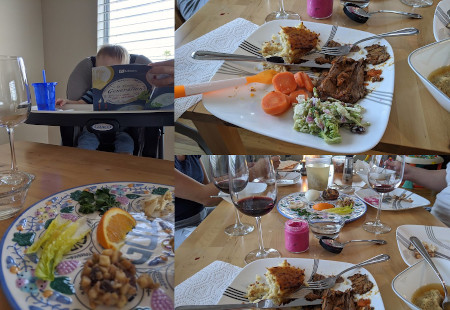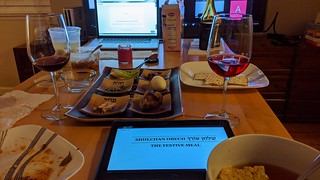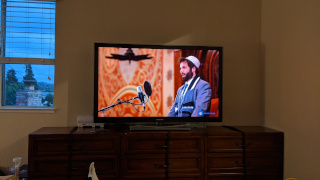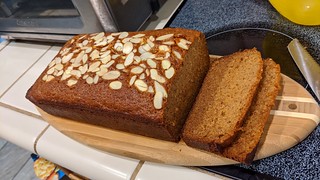We are living through a global pandemic. Today, just days after Thanksgiving, the US is enduring the biggest wave of the virus yet. Cases and deaths are increasing in areas that haven’t seen powerful previous waves before. Even where we are in northern California, where cases have trended high, but manageable, hospitals and public health officials are bracing for a crisis. With this in mind, I was quite disheartened to learn that the Thanksgiving travel surge was still occurring, with airports packed with travelers and people continuing to willfully defy public health recommendations.
Traditions are important. It was one thing that was impressed upon me when I decided to go down the Jewish path with MJ in our marriage and to raise our children Jewish. Whether it was repeating the same meal during Passover every year with the same Exodus story or reflecting upon the past year during the High Holidays, as someone new to these traditions they made an impact on me. Now, perhaps someone who has experienced them their whole life may not see it, but the fact that repetition and tradition are so woven throughout much of Judaism and other religions is something that caused me to pay attention to it.
So what do we do when that tradition is disrupted? It’s hard, but we’re adaptable. In fact, I learned this year that changes to the underlying tradition can sometimes make things more meaningful and memorable.
With all of the major, family gathering Jewish holidays already behind us for 2020 and all celebrated during the pandemic, and with Christmas around the corner, I wanted to share thoughts and experiences my Jewish family has had this year.
Many congregations have closed their doors since March, including ours. Everything we’ve done has been virtual, and our first big holiday occurred in April as we celebrated Passover. Passover consists of a ritual meal called a Seder, during which you read portions of Exodus to focus upon Moses leading the Israelites out of slavery in Egypt. Many families do two Seders, one with their family at home, and a second night community Seder with their broader community. MJ and I have typically just done the community Seder, with the exception of when we’re in Philadelphia for Passover and we do a first night family Seder.
This year we did both for the first time!
We ordered food from Wise Sons, a Jewish deli in San Francisco. They provided all the pieces for the ritual Seder plate, and we also did catering from them of traditional foods for the real meal following the Seder. We read from new Haggadahs, shipped to us from PJ Library, and muddled our way through the traditions. Doing this on our own was a real learning experience and one I will truly treasure. Our past reluctance to do it ourselves mostly stemmed from not wanting to make a fuss for just the two of us, but now that we were finally nudged into doing this family Seder ourselves, we’re much more likely to do it moving forward as our family grows.
The second night was up in the air. How can you do a “community Seder” without physical contact with your community? We went in an entirely new direction for this. Our synagogue hosted a virtual Seder, but with the whole world open to us, why not try something new? Instead, we were invited to do one led by a fellow Philadelphia transplant to the Bay Area who was hosting a Zoom-based Seder with his friends from across the country. A Seder over Zoom would have been unthinkable in years past, and we weren’t sure how it would go, but it was the responsible thing to do and we found it to be quite enjoyable! We were able to experience the meal with different people, some of whom weren’t Jewish, and from a different Jewish perspective (led by a conservative, rather than reform, which we are).
Passover 2020 was unusual, but memorable and special in so many ways. We missed seeing on congregation, but fellowship was possible, we were all safe, and we kept our communities safe.
September marked the arrival of Rosh Hashanah and Yom Kippur, the High Holidays, the most important holidays on the Jewish calendar. Commemorating the Jewish New Year and Day of Atonement, respectively, these are traditionally held in the synagogue with services beginning in the evening, people adjourning home for the night, and returning the next morning for a day of services and holiday-themed events. Yom Kippur itself is a fasting holiday, which concludes with a large community meal to break the fast.
With how important these holidays are, it may seem unthinkable to not gather together for them. I admit, it was tough being away from everyone, especially since we hadn’t gathered with the congregation in some time. In some ways the High Holidays didn’t make as much of an impact this year because we couldn’t be together. In other ways, they were more meaningful. Sacrifice for the good of the community are core tenants of most religions, and Judaism is no different. By forgoing the in-person gathering for the safety of the congregation and our community around us, were were making a sacrifice very appropriate to the spirit of the faith, and that holds tremendous meaning when you pause to frame it that way. Going without a big gathering this year means that most of us will be there to celebrate next year, and many years to come.
Our congregation did several Zoom-based events, and then pre-recorded services, which were then released on YouTube. We were able to watch the evening and morning services from home, which was actually quite nice with the tough pregnancy and with a toddler running around. The services were nicely done, but not too nice as to make us feel like we were watching a polished production. It was meaningful and special in its own way.
Being distant from our congregation also led me to experiment a bit. Since we’d always been at the synagogue for Rosh Hashanah and enjoying all the baked treats and goodies to celebrate the new year, I’d never had anything at home. Last year in Philadelphia we picked up some honey cake, but that was about it, all celebrations were outside the house. This year, without access to the congregation’s array of foods, I decided to take the time to make honey cake. It turned out great, and now we have a recipe to use in the future to enjoy part of Rosh Hashanah at home with a new tradition.
Another thing many religious organizations have been doing is special fundraising drives to address the needs of the more vulnerable community members. Giving has always been a big part of Jewish traditions, but the need is more obvious this year as we’ve heart-breakingly watched those without safety nets be left behind and put into truly dire positions. As this year winds down, more turmoil faces those who are most vulnerable to this pandemic as even more of those safety nets are disappearing, both health-wise and employment-wise. It’s truly a time to pause and be grateful that we have jobs and homes, and it epitomizes what I always thought was key to the Christmas season, even if I no longer celebrate the holiday itself.





